9.4 /10 1 Votes
Genre Racing video game | 4.7/5 Emuparadise Cabinet Sit-down, upright Initial release date 30 June 1986 Series OutRun | |||||||||||||||||||||||||||||||||
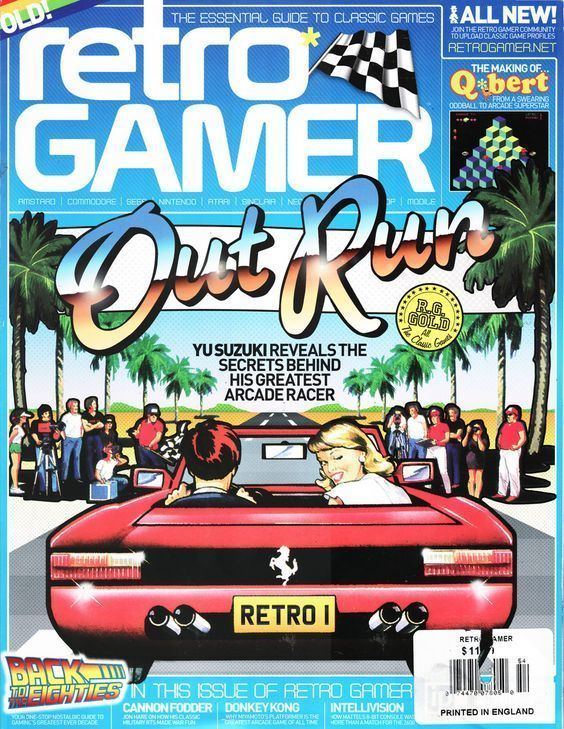 | ||||||||||||||||||||||||||||||||||
CPU 2× 68000 @ 12.5 MHzZ80 @ 4 MHz Developers Sega, Sega AM2, Sumo Digital, NEC, Acclaim Cheltenham, SEGA Mobile Similar OutRun games, Yu Suzuki games, Racing video games | ||||||||||||||||||||||||||||||||||
Out Run (アウトラン, Auto Ran) is an arcade game released by Sega in 1986. It was designed by Yu Suzuki and developed by Sega AM2. The game was a critical and commercial success, becoming one of the best-selling video games of its time, winning the Golden Joystick Award for Game of the Year, and being listed among the best games of all time. It is notable for its innovative hardware (including a moving cabinet), pioneering graphics and music, innovative features such as offering the player choices in both soundtrack and nonlinear routes, and its strong theme of luxury and relaxation. In retrospective interviews, Yu Suzuki has classified Out Run not as a racing game, but as a "driving" game.
Contents
Gameplay
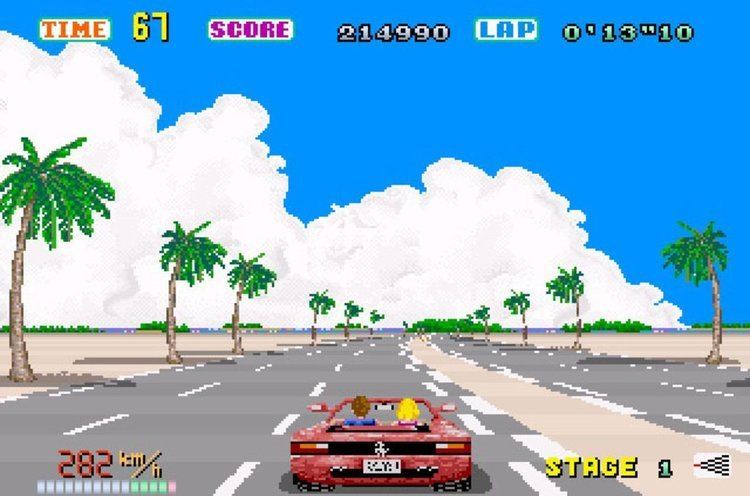
Out Run is a 3D third-person racing game. The player controls a car, a Ferrari Testarossa Spider, from a rear third-person perspective. In contrast to other third-person racing games at the time where the camera is some distance above the horizon to see into the distance, Out Run places the camera near the ground, directly behind the car, simulating a Ferrari driver's perspective view and limiting the player's view into the distance. The road also curves and dips, which, combined with the low perspective, increases the challenge by making it difficult to see what is on the other side of a hill.
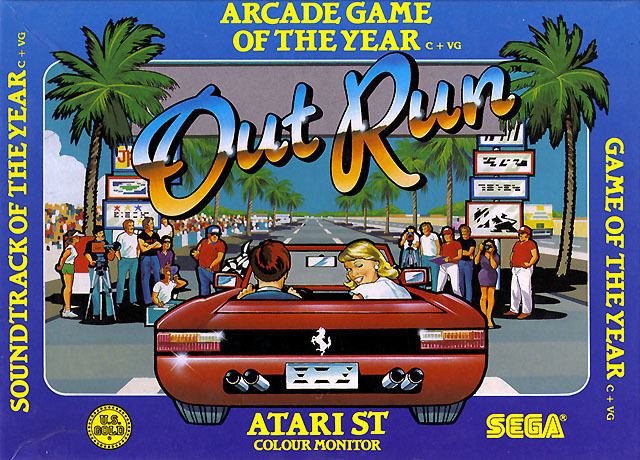
The player must race to the end of each stage as fast as possible against a time limit while avoiding traffic. At the end of each stage, the player is presented with a fork in the road where the player must choose one of two stages. The left route presents an easier stage, while the right offers a greater challenge. Passing through checkpoints awards the player with extra time. Once the timer reaches zero or the player completes the race, the game ends. In addition to the nonlinear gameplay, Out Run also offered the choice of music to listen to while driving, represented as radio stations.
History and development
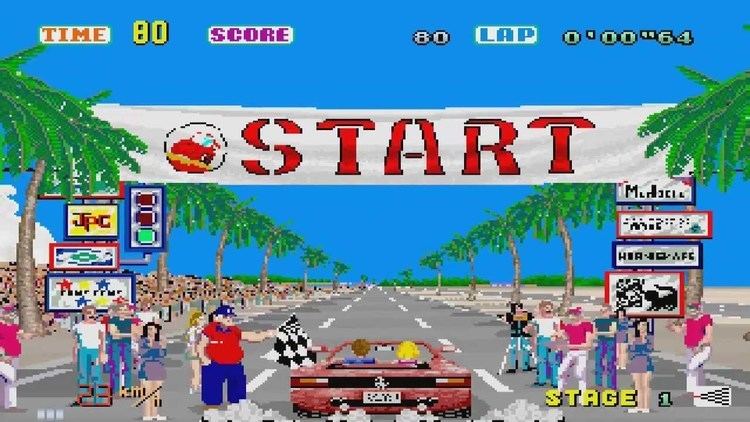
The arcade game features raster graphics on a color CRT monitor and amplified stereophonic sound. There are a total of four cabinet designs (two upright and two sit-down), all of which are equipped with a steering wheel with force feedback, a stick shift plus acceleration and brake pedals. The upright cabinet came in two versions: Normal and Mini. The sit-down cabinets resembled the in-game car and used a drive motor to move the main cabinet — turning and shaking according to the onscreen action. There were two versions of the sit down: the Deluxe version featured a 26-inch color monitor and a custom molded seat, while the Standard featured a more simplified design and a 20-inch color monitor.
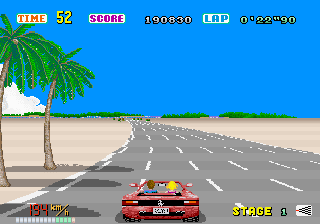
Running on the Sega OutRun arcade system board, Out Run achieved its 3D effects using a sprite-scaling technique called 'Super-Scaler' technology (first used one year earlier in Hang-On and Space Harrier). This allowed a large number of scaled sprites to be displayed on the screen at the same time. Like the Sega Space Harrier games, the pseudo-3D sprite/tile scaling in Out Run was handled in a similar manner to textures in later texture-mapped polygonal 3D games of the 1990s. Sega AM2's Yu Suzuki stated that his "designs were always 3D from the beginning. All the calculations in the system were 3D, even from Hang-On. I calculated the position, scale, and zoom rate in 3D and converted it backwards to 2D. So I was always thinking in 3D."
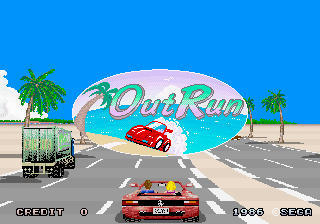
Most previous racing games had commonly used a bird's eye view. Out Run had great amounts of roadside detail and a "camera" that appeared to travel along the road with the car, passing through the action rather than merely observing it. According to the game's designer, Yu Suzuki, the stages of Out Run are mostly based on European scenery; he had toured Europe for a period of 2 weeks in order to gain insight on how to design the game's levels and capture as much realism as possible. His original concept was to base the game on The Cannonball Run but he switched the setting to Europe which offered greater landscape variation. The game's backgrounds and roadside objects include old stone buildings, the Alps, windmills, and Stonehenge-like formations. Other stages include Devil's Canyon and Death Valley.
Music
The game's accompanying music was written by Hiroshi Kawaguchi, who had previously composed soundtracks for other games designed by Yu Suzuki, and was part of Sega's official band at the time, the S.S.T. Band. Out Run was the first video arcade game that allowed the user to choose the background music, a soundtrack of both laid-back beach music (very similar in style and tone to the popular '70s/'80s Japanese jazz fusion band Casiopea), and some Miami Sound Machine-styled Latin/Caribbean beats. Three selectable tracks were featured in all and were broadcast through imaginary FM Radio stations received by the radio receiver in the Testarossa. The three tracks were titled Passing Breeze, Splash Wave and Magical Sound Shower. An additional track, Last Wave, played after completion of the game when a player could insert their initials next to their score.
The Master System's Out Run 3D replaces Passing Breeze and Splash Wave with songs called Color Ocean, Shining Wind and Midnight Highway, written by Chikako Kamatani, while the 1991 Mega Drive/Genesis port features an extra track entitled Step On Beat, written by Masayoshi Ishi. Meanwhile, the Nintendo 3DS version features two additional tracks known as Cruising Line and Camino a Mi Amor, composed by Manabu Namiki and Jane-Evelyn Nisperos (also known as Chibi-Tech), respectively.
Home conversions
Out Run was ported to many of the home consoles and computer systems of the time. Due to the various hardware limitations of these systems compared to the dedicated arcade hardware, some ports came bundled with a bonus cassette tape featuring the original arcade versions of the game's soundtrack, the idea being that the player could listen to the true versions while playing rather than the limited home computer renditions, if they were available at all.
Commercial reception
Upon release in 1986, Out Run became one of the most popular games in the arcades at the time. It was the best-selling arcade game of the year, having sold over 20,000 arcade cabinets within a year. It went on to sell 30,000 arcade cabinets worldwide, as of 1994.
The 8-bit computer game ports published by U.S. Gold in 1987 sold over 200,000 copies within two weeks, during the pre-Christmas period, making Out Run the fastest-selling game in the UK up until that time. The home computer versions eventually sold over 250,000 copies by Christmas 1987, making Out Run the best-selling computer game of 1987 in the UK.
Critical reception
The arcade version was well received upon release. Commodore User reviewed the arcade game in its March 1987 issue, describing it as "a great game for driving enthusiasts" and giving it a score of 9 out of 10. In the January 1987 issue of Computer and Video Games, Clare Edgeley gave the arcade game a positive review, stating that "the low viewpoint of the road" and "swaying motions of the car" make it "a very exciting game to play." She compared it to Konami's rival WEC Le Mans, giving Le Mans "the edge" for "movement" but noted that "many seem to prefer Out Run." Clare Edgeley reviewed the arcade game again in the February 1987 issue of Sinclair User, where she criticized the use of "blondes to portray glamour" but stated that where Out Run "scores is with its graphics," noting that "they're better" than WEC Le Mans due to "the angle you view them. Because the Ferrari is so low slung" and "two feet off the ground," the player "can't see far ahead and, when cresting a hill, you don't know what's on the other side," giving it a "danger element," concluding that it is "an unusual view and one that works brilliantly." In the April 1987 issue of Crash, Gary Penn also gave the arcade game a positive review, describing how "the roadway curves and dips" and "the 3D scrolling" as "wonderful" and stated that the game is "highly polished," praising the "excellent" music, "graphics and sound," and attention to detail, such as the way the female passenger "wags an admonishing finger" after a crash. He described "the complete cockpit implementation" as "a thrilling experience" and gave it "the edge" over WEC Le Mans "in both game-play and presentation," concluding that "Out Run's moving cockpit is more believable, and the added touches make the whole thing more believable." In the August 1987 issue of Your Sinclair, Peter Shaw described it as "the most frighteningly fast road race game I've ever played" and praised "the realism," noting how "when you bump into things, like the road edge, cars, trucks and trees, the whole machine rocks and vibrates, and the steering wheel wobbles in your hand." He recommended the deluxe version, "with its moving cabinet, 26 inch monitor and 1,888K" (236 KB) "graphics memory," concluding that "it's fantastic!"
The 8-bit console Master System port released in 1987 was also well received. It received a score of 9 out of 10 from the October 1987 issue of Computer and Video Games, which concluded that "Outrun on the Sega has all the thrill power of the arcade version." It also received scores of 852 out of 1000 from the British ACE magazine, and 17 out of 20 from the Finnish Tilt magazine. The Games Machine gave the Master System version a score of 72%, stating that, "Of all the versions," the Master System port "comes closest to the original coin-op" but that "nonetheless, it does suffer in comparison" to the arcade original. It was reviewed in 1988 in Dragon #137 by Hartley, Patricia, and Kirk Lesser in "The Role of Computers" column, where the reviewers gave the game 4½ out of 5 stars. They described it as a "racing simulation" with "refreshing differences," pointing to the branching paths and music selection choices, and praising the game as "a very fine Sega simulation that provides hours of entertainment." Computer Gaming World named it as the year's best arcade translation for Sega. The French magazine Génération 4 gave it an 82% score that same year.
The reception for the 8-bit personal computer ports published by U.S. Gold were generally mixed, depending on the quality of the conversions. The ZX Spectrum version received positive to average reviews. It received positive scores from Your Sinclair, which gave it 8 out of 10, and from Sinclair User, which gave it scores of 8 out of 10 in March 1988 and 81% in November 1990. Crash magazine gave the Spectrum version a 72% score based on three individual reviewers, Nick, BYM, and Mike, giving scores of 93%, 63%, and 59%, respectively, with the latter two reviewers expressing disappointment at the lower conversion quality in comparison to the arcade original. The Games Machine gave the Spectrum version a score of 61%, noting the machine's technical limitations in comparison to the Master System and Commodore systems.
The Commodore 64 and Commodore 128 versions received positive to average reviews. The Games Machine gave the Commodore 64 and 128 versions a 67% score, higher than the Spectrum port but lower than the Master System version. The Australian Commodore and Amiga Review magazine gave the Commodore 64 version a high 95% score. Computer and Video Games, which referred to the arcade original as "the ultimate coin-op driving game," described the Commodore 64 port as a "rushed" conversion and gave it an overall score of 24 out of 40. The Amstrad CPC port received a negative review from Computer and Video Games, which described this version as a "travesty" and gave it a score of 8 out of 40.
The 16-bit Atari ST version published by U.S. Gold in 1988 was more well received than their earlier 8-bit computer ports. Computer and Video Games gave the ST version a positive review and an overall score of 7 out of 10, including 7 out of 10 for each of the three categories of graphics, sound, and playability. The magazine stated that, though this version is "a far from perfect conversion," it comes closer to the arcade original than the other computer ports. ACE magazine gave the Atari ST version a high score of 873 out of 1000. while The Games Machine gave it a 79% score, noting that it is an "admirable conversion of an incredible coin-op" but is still lacking in comparison to the original arcade game.
In 1989, ACE magazine gave U.S. Gold's 16-bit Amiga port a score of 822 out of 1000, while The Games Machine gave it a 75% score. The 16-bit console Mega Drive / Genesis version of the game released by Sega in 1991 received a score of 85% from the Swedish Svenska Hemdatornytt magazine that same year. This version later received a score of 9 out of 10 from Sega-16 in 2004.
Awards
In 1988, Out Run was voted as 1987's Game of the Year at the Golden Joystick Awards, beating Renegade and The Last Ninja for the award. Out Run also received the Arcade Game of the Year award, beating Renegade and Bubble Bobble for the award.
Out Run has been listed among the best games of all time, by publications such as Next Generation, Retro Gamer, Stuff, and Time, as well as organizations such as G4, Killer List of Videogames, NowGamer, and Yahoo! Writing in 1001 Video Games You Must Play Before You Die, Joao Diniz Sanches praised Out Run's "unforgettable design and expertly tuned game balance", describing the title as "the consummate exhibit in an oversubscribed genre" and "one of the purest and most joyous experiences in video gaming."
Legacy
In the arcades, Out Run was followed up in 1989 by Turbo Out Run. Turbo Out Run was a checkpoint racer in which the player drove from New York City to Los Angeles in 16 stages. It featured a rock-infused soundtrack. As with all Out Run games aside from OutRun 2, this is named by Yu Suzuki as an unofficial sequel. The game Rad Racer was based on it.
Another unofficial sequel came in 1992 with OutRunners, returning the game to its roots by bringing back the forks in the road. Head-to-head support appeared in the game for the first time, and if arcade cabinets were linked, up to eight drivers could race against each other. The game also featured eight different cars for people to drive in. It was the most successful game released for Sega's System Multi 32 hardware, and one of the last successful 2D games released by Sega.
In 2003, the series made the jump to 3D graphics with the arcade release of OutRun 2 (featuring actual licensed vehicles from Ferrari, including a Testarossa). Yu Suzuki, the creator of the original Out Run, was on hand to bring his vision up to date, earning OutRun 2 great critical acclaim and the distinction of being the first official sequel to the original. The Xbox release added features such as new cars, new audio tracks and even a fully playable version of the original Out Run.
An updated version of OutRun 2 was released in arcades in 2004 entitled OutRun 2 SP. This expanded upon the original by offering a plethora of tracks to drive through, including the original map. It also improved on graphics and added more tunes to listen to while driving. It featured the 512 BB and 250 GTO, which were also featured in the Xbox version of the original OutRun 2.
In turn, OutRun 2 was succeeded by OutRun 2006: Coast 2 Coast, developed for the PlayStation 2, PlayStation Portable, Xbox and Microsoft Windows. The game combines all the courses from OutRun 2 and OutRun 2 SP while adding additional features of its own, such as special car models, new game modes and more audio tracks. It also contains an "OutRun 2 SP" mode itself, meant to be an exact arcade port of OutRun 2 SP.
OutRun Online Arcade was released on Xbox Live Arcade and PlayStation Network in 2009. This downloadable game included only the tracks from OutRun 2 SP.
There are three other unofficial OutRun games that were only released for home systems: Out Run Europa (started in 1989, and completed in 1991), Battle Out Run (1989), and OutRun 2019 (1993). On the Master System, there is also a special version of Out Run which makes use of the 3D glasses add-on.
Coconut Beach, the first stage in Out Run, makes an appearance in Sega Superstars Tennis as a playable court. A course based on the series, named "OutRun Bay", appears in Sonic & All-Stars Racing Transformed as a free download to those who purchase the Bonus Edition. The game also features Ryo Hazuki from Shenmue as a playable character, driving an Out Run sit-down arcade cabinet during land-based portions of a race. The car the Mii drives is inspired by the Car on the box art of the home ports.
In 2015, OutRun appeared at 4th place on IGN's list of The Top 10 Most Influential Racing Games Ever, behind Pole Position, Gran Turismo and Virtua Racing. According to Luke Reilly, OutRun's selectable "radio stations", "undulating tracks, and a killer cockpit-style cabinet" was "unlike any racing game out there in 1986." He said it proved "to be a hugely influential force on the genre, and traces of OutRun DNA can be found in series like Test Drive, Need for Speed, PGR, and Burnout" as well as "modern racers like the Forza Horizon games and DriveClub".
